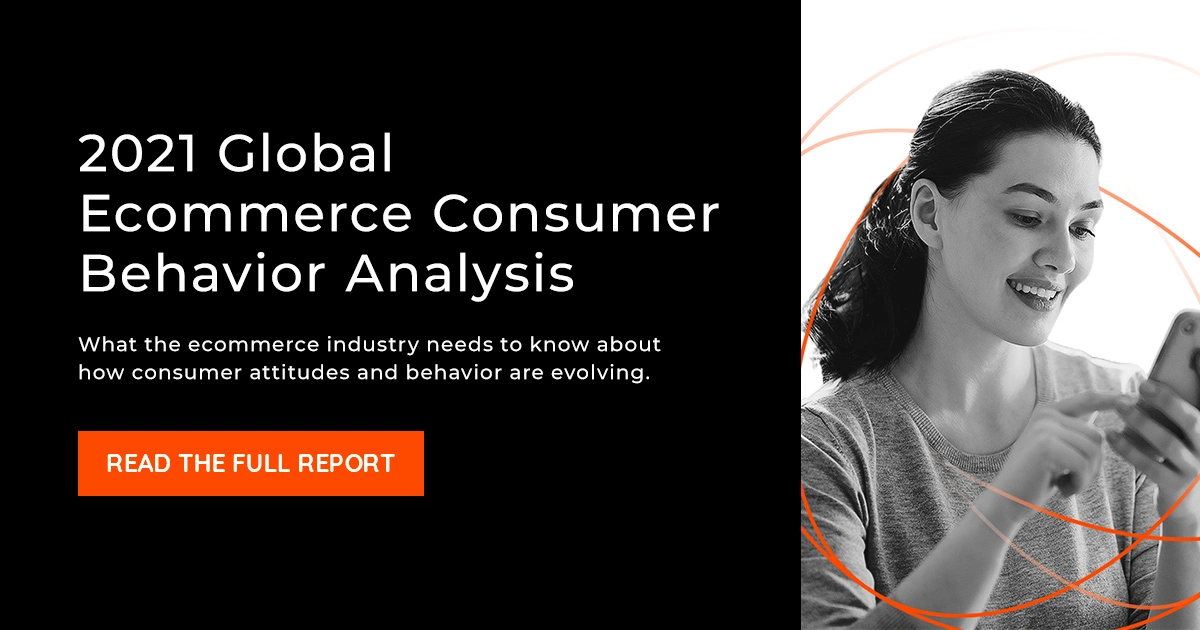Ecommerce Industry Guide: Grocery
For a long time, grocery shopping hadn’t evolved much.
Online grocery ordering came on the scene in the early 2000s but was still mostly the province of early adopters. In a 2019 survey, 36.8% of 1,888 internet-using adults polled had purchased groceries online in the previous 12 months, and of those, 72.4% had purchased only “a little.”
Then the pandemic happened.
Stay-at-home orders sparked a stampede toward online grocery shopping nearly overnight. The urgent need for customers to grocery shop while staying at home changed the industry forever.

Ecommerce Grocery Shopping Challenges and Opportunities
Although the end result of online grocery shopping is familiar — restocking a home with bags of groceries — the path customers take is still a bit thorny.
More Shopping … But Less Fun?
While many customers enjoy browsing and buying from their digital devices, others find online food shopping far more difficult than the in-person experience. Customers who go digital miss the interactive opportunities that in-person shopping offers, like tasting a savory new cheese, sniffing out the perfect scented candles, feeling the silkiness of a shirt, or taking in the beautiful seasonal displays.
Product sizes can be hard to discern from small product photos, and even the browsing experience can be cumbersome and time-consuming if you can’t narrow a search of “chicken” down to the specific piece of meat or canned good you want.
Surprisingly, such challenges often aren’t reflected in the final purchase. Instead, the average basket size for click-and-collect orders is significantly higher than for in-person shops.
A likely reason? Online shoppers are often eager to reach minimum purchase requirements to get shipping or pickup charges waived. Adding items to the basket for online shops can also be done at a shopper’s convenience over several hours — or even days — making it easier for shoppers to double-check their pantries to ensure they’re not forgetting anything.
The End of the Impulse Purchase?
Despite their bigger basket sizes, however, online shoppers tend to be less adventurous than their in-store counterparts. After all, they can’t be swayed by free samples, or eye-catching endcap displays. So, they tend to shop well-known or familiar brands or buy the same products week after week, a phenomenon McKinsey has called “grocery rut” and which can make it hard for grocers to tempt them with impulse purchases.
This has emerged as one of the biggest flaws in online grocery shopping. During lockdown lots of online shoppers were reportedly irritated by grocery retailers for making it easy to buy the same thing but not to find new food and products to try.
Fortunately, shoppers are becoming a bit more exploratory, at least when it comes to purchase categories. Initially, online grocery customers tended to buy staples more than perishables, perhaps concerned they would be given overripe or near-expiry products. Over the course of 2020, perhaps persuaded by happy ordering experiences, online shoppers’ openness to purchasing fresh and perishable foods online has increased:
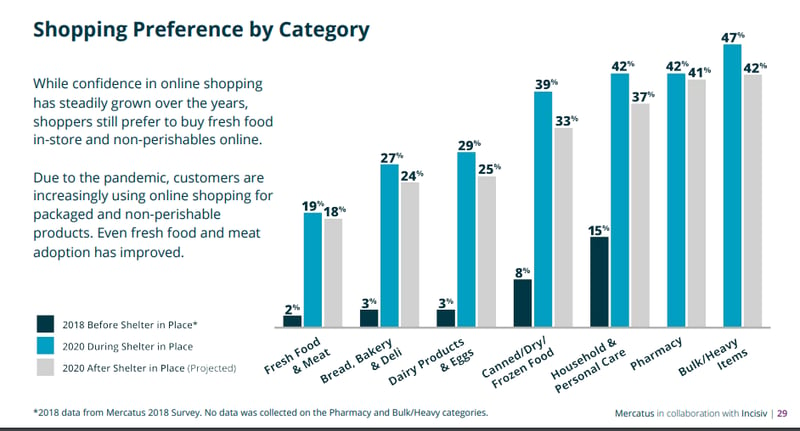

How Late Adopters Learned to Love Online Grocery Shopping
Prior to the pandemic, baby boomers and members of the silent generation were late adopters of online grocery shopping. In 2019, only 18% of Baby Boomer respondents said that they had ordered groceries online.
From the start of the pandemic, seniors were warned they were at greatest risk, so it’s no surprise they welcomed a safer option to accomplish a necessary errand. Indeed, one in three people over the age of 55 who bought their groceries online in March 2020 did so for the very first time, and recent data from the U.S. Bureau of Labor Statistics shows that 28% of baby boomers and silent generation shoppers increased their online grocery purchases during COVID.
At Instacart, shoppers in the 60-plus category order groceries 25% more frequently than their younger peers and spend 35% more on household items, such as cleaning supplies and paper products. This aligns with recent research that household items are one of the categories shoppers 55 and older are likely to purchase online:

With ~103 million people over the age of 50 in the United States, these shoppers make up one of the country’s largest consumer demographics. This population represents a major marketing opportunity for ecommerce merchants because whether now or in the future, mobility issues may limit their ability to drive to a store or to carry groceries.
The opportunity might be even larger than previously thought. The silent generation was never considered a segment of the market for ecommerce. Yet they are among the most vulnerable cohort of people during the pandemic … and they’re finally using ecommerce services, especially for groceries.
A McKinsey & Company survey showed that 30% of consumers aged 65 and above were planning to increase their online shopping habits, even once shops open their doors again. As ecommerce sites prepare to welcome these silver surfers, they need to be aware that fraud prevention and data security are high priorities to this cohort:
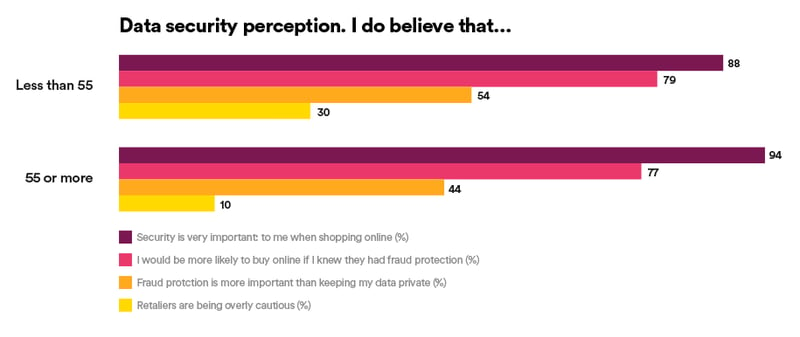

How Grocery Ecommerce Will Grow
Per eMarketer, online grocery sales in the US will have grown by nearly 53% in 2020, reaching $89.22 billion in sales. That’s an increase of $30.86 billion from a year prior. By 2023, ecommerce grocery sales will reach $129.72 billion and will account for nearly 10% of total grocery sales.

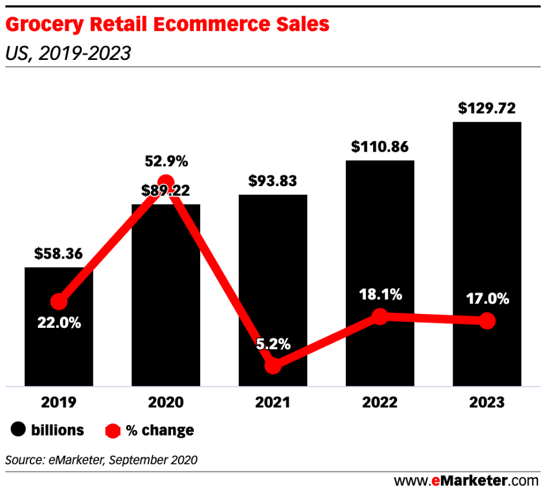
While it may seem like everyone is grocery shopping online now, ecommerce penetration hasn’t yet reached its peak, according to a forecast from Business Insider:
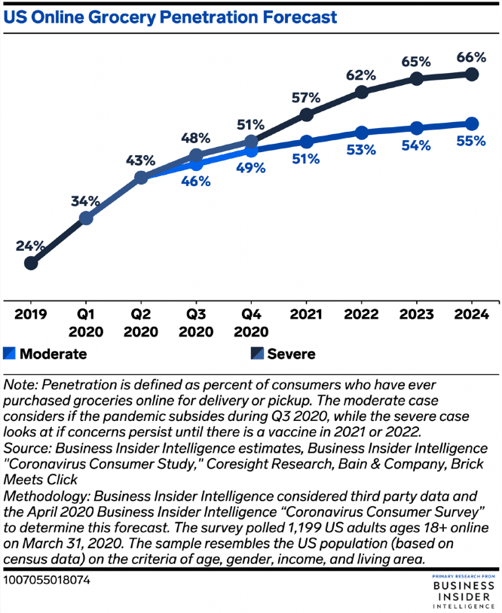
Even post-pandemic, the growth will continue. A report from Mercatus projects that online grocery will account for 21.5% of total grocery sales by 2025 – an estimated $250 billion and a greater than 60% increase over pre-pandemic estimates.

If the grocery industry wants to take advantage of this evolving market, here’s what they need to know.

How COVID-19 Has Shifted Grocery Ecommerce
The COVID-19 pandemic has fed the rise of grocery shopping home delivery services like Instacart and Shipt. These services add another layer of personalization, with shoppers contacting the customers for questions about substitutions and offering to make last-minute purchases. Customers benefit from the convenience of having their weekly shopping — or even impulse late-night snacks — delivered straight to their door. They also enjoy perks like:
- Attractive discounts & promotions
- Stock availability
- Availability of fulfillment options (curbside, free home delivery by brand or partner)
- Other online order incentives
The convenience offered by these major home delivery services are winning customers over from preferred brick-and-mortar retailers that offer similar but less sophisticated services. While overall adoption of online grocery shopping has grown by close to 200%, only 26% have shopped online with their preferred brick-and-mortar grocer.

Whether they are using home delivery services or ordering online from preferred brick-and-mortar retailers, the majority of online shoppers have formed comfortable relationships with their providers. This is a change from the early days of the pandemic. “Intent to repeat” with the same online provider was just 43% in March 2020, by November it was more than 80% – and “intent to repeat” has risen steadily throughout the pandemic, even increasing 8 percentage points just between August and November.
Online grocery shopping isn’t just a United States trend. The pandemic has catapulted online grocery sales internationally; since the pandemic started, new customers have boosted the number of online grocery buyers by 30.0% globally. Grocery ecommerce penetration doubled in Italy, rose from 8.1% to 12.4% in the United Kingdom, and jumped from 6% to 10.2% in France. Online grocery's COVID-19 surge is expected to last well beyond lockdown in the U.S., U.K., France, Germany and Italy.
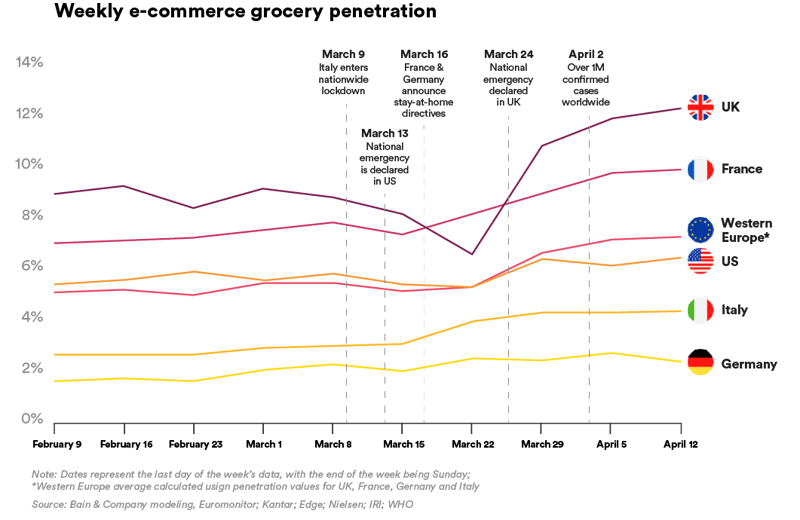
And this shift in shopping is likely to outlast the pandemic. Shoppers are changing their priorities, focusing on maximizing time spent with family versus completing household tasks that can be outsourced. And now that shoppers are familiar with navigating stores’ apps and have enjoyed the convenience of click-and-collect groceries, they’re more likely to continue online grocery shopping even after they feel comfortable returning to stores.
Grocers who can keep needed items in stock and offer flexible, free, and prompt pickup are those who will win over customers and benefit from this new shift to digital.

Grocery Ecommerce and Industry Technology
Grocery merchants are no strangers to technological innovation. From the self-check-out lane to smart carts to cashierless stores, the industry has been applying innovation in the pursuit of efficiency and a better shopping experience for years.
2020 has put those efforts on steroids.
A new study reveals that one in four Food Services and Food Retailers now view their companies as tech-forward early adopters:

- 71% cited digital transformation as very important to business agility, more than any other factor
- 78% indicated that contactless payments are in much greater demand, resulting in the adoption of a number of solutions including food lockers for pick-up, facial recognition kiosks, and vehicle/license plate recognition
- 53% believed their customers are more willing to opt-in to personally-identifiable recognition technologies for the sake of convenience and personal safety
Digital Innovation in the Grocery Industry
To bridge the gap between the physical and online grocery shopping experiences, some stores have been experimenting with virtual walkthroughs, using the same technology realtors use for home walkthroughs (it operates similarly to Google Earth’s street view). This allows shoppers to leisurely browse the shelves from the comfort of home, providing the benefits and comfort of a visually familiar shopping experience.
Grocery retailers may also want to evaluate whether emerging voice ordering technology can help them attract and retain customers. While shoppers are becoming more familiar with using voice technology to reorder items on Amazon via Alexa devices, they may not yet be willing to order groceries through Internet of Things devices without being able to confirm they’re ordering what they think they are, much less being unable to see the product itself.
The ease of checkout and payment can make or break the relationship between an ecommerce merchant and customer. Our own research shows only 40% of ecommerce shoppers have their credit card within easy reach while shopping, so accepting payments via e-wallets and other methods can help keep more of those customers in the checkout flow.
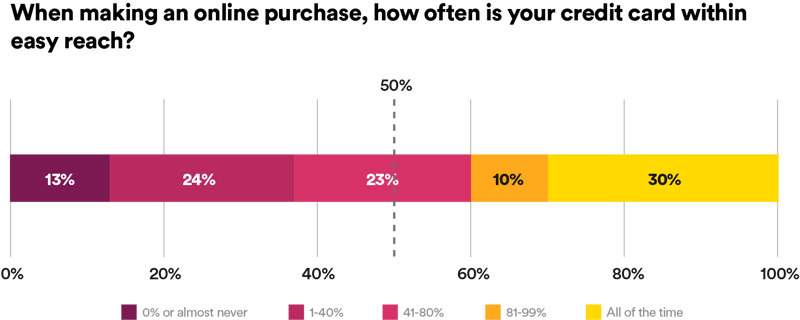
Digital wallet apps and QR payment codes that provide a no-touch experience or contactless payment option are expected to be key in the shift toward a cash-free economy. As of now, most ecommerce businesses accept digital wallets (like Google Pay, Samsung or Apple Pay, and PayPal) apart from debit and credit cards. These easy, one-touch payment experiences are especially appealing to younger demographics, which is why it is important for ecommerce merchants to put themselves in customers’ shoes when identifying the right payment options to offer.
Alternative payment options have seen a boost in usage during the pandemic and may help speed up the transformation of some shopping experiences. Cryptocurrencies, especially Bitcoin, have many benefits for online shop owners, such as low transaction fees and no reverse transactions. In 2021, we might see more ecommerce businesses accepting cryptocurrencies for transactions.

Grocery Ecommerce: Big Opportunity, Big Fraud Risk
Ecommerce fraud attackers are taking advantage of the rapid shifts COVID-19 has brought to application usage. Traffic to food delivery apps has skyrocketed and fraudsters are following the money. This means more opportunities for fraud such as:
- Theft of credit card and financial information
- Placing unauthorized orders for goods or services using hijacked accounts
- Draining new pools of loyalty points to resell on the dark web
- As online merchants push application changes more quickly, more bugs and vulnerabilities go live.
As merchants implement and refine their fraud protection, it’s crucial to have an in-depth understanding of how consumers will react to any new fraud prevention strategies and processes. Merchants must walk a fine line between protecting their business and pleasing their customers. Want to gain more insight on consumer attitudes toward ecommerce and fraud? Don’t miss out on our exciting new study, where we reveal what consumers – in different locations, of different ages, of different genders, and at different spending levels – think, and how you can keep them happy and coming back to buy more.
 Sarah Elizabeth
Sarah Elizabeth




![[Related Reading] Retailers Have Got COVID-19 Problems](https://no-cache.hubspot.com/cta/default/2530812/5c22a1d9-b95c-431e-9a9a-5d48c83f5e3d.png)

